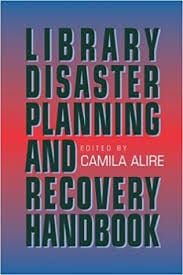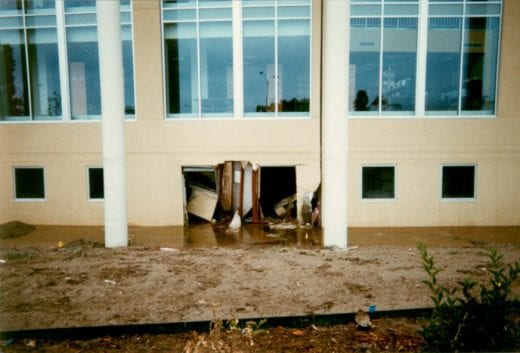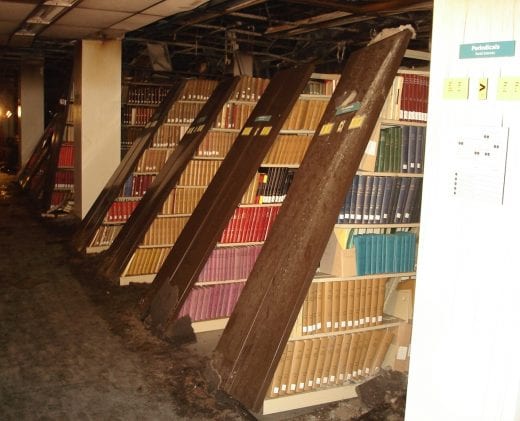The Hale Library fire was unprecedented. Even after the smoke cleared and K-State Libraries’ employees went back to work, it can still be difficult to comprehend the scale of the damage.
“We’ve got 1.2 million volumes that need to be restored and we’ve taken the interior of the library down to the studs,” Lori Goetsch, Dean of K-State Libraries, said. “It’s very significant. That we know of, there is not an academic library in the United States that has experienced devastation at this scale.”
At the July 18 K-State Libraries all-staff meeting in Leadership Studies’ Forum Hall, we turned to Camila Alire, a retired library Dean from Colorado State University (CSU) and the University of New Mexico (UNM), for perspective. Alire is known as “the disaster queen,” having been through not one, but three library crises. She has literally written a book on disaster, “Library Disaster Planning and Recovery Handbook.” In her retirement, she acts as a consultant for libraries who experience similar setbacks.

“Your disaster is extremely hard,” Alire said. “Not only did you have fire, but also you had the water damage. It is going to take you a long time to be back whole again, but I would tell you that this, too, shall pass.”
Goetsch asked Alire to talk to the K-State Libraries’ staff as we consider our future as a library and think about what we can expect during the recovery process. Her hope was that talking about the disasters she has experienced would help give staff members perspective on how to act and react.

“We have all been through a stressful ordeal and there is a lot of uncertainty with that,” Goetsch said. “I invited Camila to our staff meeting to help them understand what we might go through in the next few years.”
On July 28, 1997, just nine days after Alire started her job as Dean of CSU Libraries, Fort Collins experienced major flooding from the Cache La Poudre River. The entire city was affected, but the library was the campus building that was hit the worst.
In only four hours, they received six inches of rain. The water flowed quickly at 5,000 cubic feet per minute and put extreme pressure on the outside library wall. This pressure broke an eight-foot hole in the wall and flooded the entire basement, damaging and submerging over half a million volumes.

While students were locking up the library that night, they went down to the lowest level to check for any remaining patrons, and that was when they heard a crack. They were aware enough to know that the sound was out of place, so they ran back up the stairs. Seconds later thousands of gallons of water poured into the basement, just as they reached the landing. It was the violent flow of the rushing water that did the most damage to the basement. If the water had been stagnant, the flood would not have been as destructive.
“Every bound volume that was down there [was] damaged,” Alire said. “The UFOs (unidentified floating objects) were entirely thrown out.”

A few years later, Alire became Dean of Libraries at UNM. During winter break, on Dec. 24, 2004, a pipe burst in the Science and Engineering Library. There was water damage throughout the entire building and all 300,000 volumes had to be packed out. Luckily, they got to the damage quickly and were up and running a few months later.
“The engineering library was the easiest,” Alire said. “Everything went smoothly, the consultant that they hired to come in was easy to work with, everyone got along, and it was excellent.”
She also commented that it was fortuitous that the flooding happened during a semester break: “Luckily for us—and I think this is probably an advantage when it happened [at Hale]—is you don’t have … a majority of the students and faculty here on campus in the summer,” Alire said.
Finally, on April 30, 2006, Alire faced her last crisis: A major fire in UNM’s Zimmerman Library. This was an entirely different disaster for her to deal with and most similar to what Hale Library experienced. In this case, arson destroyed 28,000 volumes and 60,000 square feet of the building. In total, soot and smoke damage covered 242,752 square feet. The heat was so intense that it melted metal on the bookshelves, but fortunately, a lot of books were salvaged.

The difference between her three disasters and the fire at Hale was the magnitude. In every event Alire experienced, the libraries were open to the public within a matter of months. Hale Library’s recovery and renovation process might take up to two years to be completely functioning.
“Dean Alire really gave some sage advice on how to get through a major crisis,” Laurel Littrell, planning and assessment librarian, said. “At the same time, it also put our situation in perspective. Even though she’s the country’s foremost expert on library disasters, none of her institutions’ experiences compare to the scope of what happened in Hale Library, especially in terms of how long the building will be closed.”
Alire preached the message that, although this disaster is difficult now, there are silver linings. In our case, Hale was going to be under renovation for the first floor, but now we have the opportunity to renovate all four floors, making the entire building better for students, staff, and faculty
Such an excellent idea to have Dean Alire come speak!